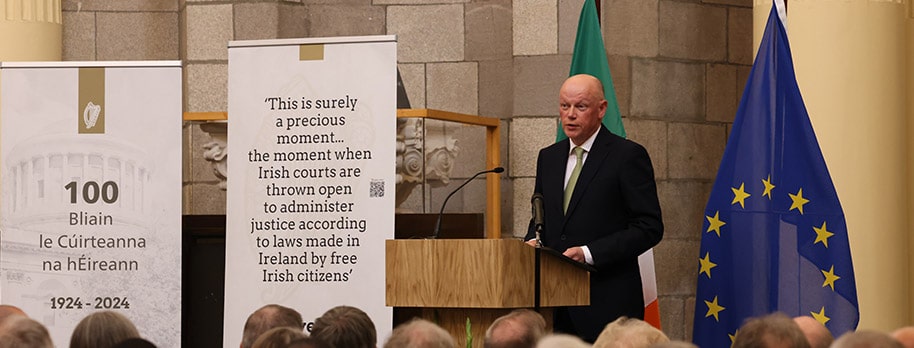
Four Courts now ‘beyond bursting point’ – O’Donnell
Chief Justice Donal O’Donnell has said that, in the next century, we should be looking to improve the conditions in which justice is administered in every courtroom
He was speaking at a commemorative ceremony held today (28 May) to mark the centenary of the Courts of Justice Act 1924 and the 100th anniversary of the establishment of the Irish courts.
This date was chosen because it was the closest non-sitting day to the date of commencement (5 June 1924) of part 1 of the 2024 act that established the High Court and, for the first time, a Supreme Court of Ireland.
‘Modern administrative office’
The chief justice told the event that the changes introduced in the 1924 act were described at the time as “striking” and “radical”, and that we should be willing to ask the same questions now that our predecessors were prepared to ask 100 years ago.
“What parts of this system are essential to a functioning legal system in a modern state, and what parts should be adapted, changed, or improved?” he asked.
He described the Four Courts building as now “beyond bursting point”, as it is now required to hold nearly 50 judges.
“I hope it will be possible to identify a suitable premises to house a modern administrative office and a judicial-office system for the 21st century, while preserving this building for its core historic function of hearing cases,” the chief justice said.
Broadcasts
He also pointed out that it was unusual for a Supreme Court not to be in a dedicated building.
“There are advantages and pleasures to working in such an historic building, but doing so should not come at a sacrifice to support, facilities, or efficiency,” he added.
He also revealed that it had been agreed, in principle, to run a pilot project, starting before the end of this year, to “consistently” broadcast hearings in the Supreme Court for the first time. Broadcasts of some judgments have previously been allowed.
Work is also underway to restore four friezes that were destroyed with the Four Courts building in 1922. The friezes, designed by Edward Smyth, depicted events relating to the imposition of English law in Ireland.
They will occupy four of eight large rectangular panels, currently lying empty, that run around the base of the inner dome of the Round Hall. Three new friezes will also be designed to depict the progress of Ireland’s justice system since 1924, while one will be left blank for the future.
Irish courts ‘pioneers’
The ceremony also heard from the Minister for Justice Helen McEntee, who said that the courts system had reshaped Irish society and democracy in the past 100 years and had continuously evolved to meet the needs of society.
Koen Lenaerts (President of the Court of Justice of the European Union) told the event that the Irish courts had contributed to the development of EU law, and had often been “pioneers”.
He added that Irish courts had often “laid the foundation stone for many new lines of case law” in the EU.
Síofra O’Leary (President of the European Court of Human Rights) traced Ireland's relationship with the European Convention on Human Rights, noting that the current low number of cases pending against Ireland reflected the “embeddedness” of the court’s standards in the Irish system, despite ECtHR judgments not having the direct effects of those from EU courts.